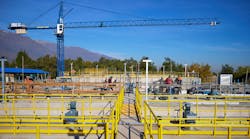Neda Simeonova is editorial director of Water & Wastes Digest. She can be reached at [email protected].
undefinedBorrowing from the popular State Farm jingle is not coincidental. According to advertising experts, a person is 10 times more likely to remember a message that’s sung to them. And even though I am not exactly going to start whistling a tune in this month’s editorial, I hope to add a few new verses to an old song.
Cities across the country have been landfilling or incinerating biomass for decades. Wastewater treatment facilities have implemented various methods to handle sludge. Typically the dewatered sludge is transported off site for disposal, or it can be land applied or incinerated. While there are pros and cons to each of these methods, ultimately facilities need to deal with sludge in a way that permits its disposal in an environmentally acceptable and sustainable manner.
Many municipal wastewater treatment facilities currently are facing difficult choices—a challenging economic climate, lack of funding and decades-old infrastructure that is beginning to crumble while the cost to rebuild is high.
With limited federal assistance and state budgets continuing to dwindle, future infrastructure costs most likely are going to translate into rate hikes. Rate hikes, however, are never easy to pass. Payers with already pressed budgets are asking questions about municipal processes and becoming increasingly aware of the negative environmental impacts of certain practices. In other words, they expect to see that their hard-earned dollars are spent on environmentally safe and sustainable wastewater management.
As a result, facilities in the U.S. are finally gaining a strong foothold in waste-to-energy practices, converting municipal solid waste into power. Solution providers also are responding quickly to this market trend by releasing technologies to address these needs.
A new analysis in Frost & Sullivan’s “Key Opportunities in Waste-to-Energy Plant Market” finds that there are a number of new and emerging technologies that are able to produce energy from waste, which could be broadly classified based on the nature of conversion. According to the report, the intensifying quest for fossil fuel alternatives and the need to bridge the energy demand and supply gap has opened up new avenues for the waste-to-energy plant market.
Personally, I think that if we are to continue to maximize the sustainability of our country’s water and energy resources, it is time to look at waste as a resource. It is important, however, that legislation and policies are in place to ensure not only effectiveness in waste management but in air quality as well.
Download: Here


